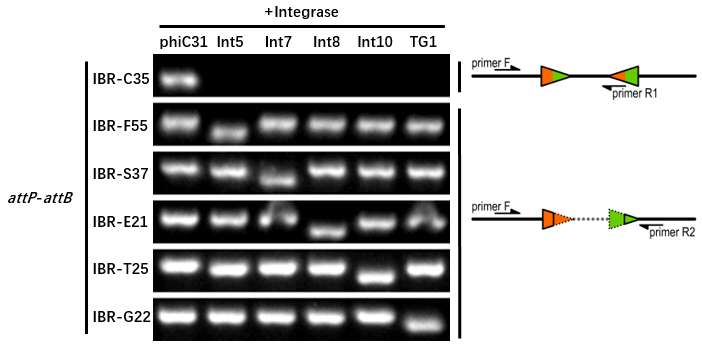Difference between revisions of "Part:BBa K3254007"
Zongyeqing (Talk | contribs) m (→Genetic design) |
|||
| (4 intermediate revisions by 2 users not shown) | |||
| Line 11: | Line 11: | ||
The composition and principle of the experimental system are indicated below. More sequence details can be seen on the pages of [[Part:BBa_K3254027|BBa_K3254027]] and [[Part:BBa_K3254002|BBa_K3254002]]. | The composition and principle of the experimental system are indicated below. More sequence details can be seen on the pages of [[Part:BBa_K3254027|BBa_K3254027]] and [[Part:BBa_K3254002|BBa_K3254002]]. | ||
| − | [[File:T--GENAS_China--excision_with_backbone.PNG|200px|thumb|left| ]] | + | [[File:T--GENAS_China--excision_with_backbone.PNG|200px|thumb|left|The composition and principle of the experimental system]] |
==Experimental Setup== | ==Experimental Setup== | ||
| − | The plasmid containing the Int5 | + | The plasmid containing the Int5 expressive unit was co-transferred into E.coli DH5α host with 6 reporter plasmids containing different attP-attB sites sequences. |
| − | Then single colonies were inoculated into M9 supplemented medium for overnight growth. Then, the cell cultures were diluted 1000-fold with M9 supplemented medium with 500 μM IPTG inducer and growth for another 20 hours. All incubations were carried out using a Digital Thermostatic Shaker maintained at 37 °C and 1000 rpm, using flat-bottom 96-well plates sealed with sealing film. Finally, | + | Then single colonies were inoculated into M9 supplemented medium for overnight growth. Then, the cell cultures were diluted 1000-fold with M9 supplemented medium with 500 μM IPTG inducer and growth for another 20 hours. All incubations were carried out using a Digital Thermostatic Shaker maintained at 37 °C and 1000 rpm, using flat-bottom 96-well plates sealed with sealing film. Finally, the cultures were sampled for genotype PCR testing. |
| − | The principle of genotype identification was shown on the right of results image. | + | The principle of genotype identification was shown on the right of results image. |
| + | *M9 medium (supplemented): 6.8 g/L Na<sub>2</sub>HPO<sub>4</sub>, 3 g/L KH<sub>2</sub>PO<sub>4</sub>, 0.5 g/L NaCl, 1 g/L NH<sub>4</sub>Cl, 0.34 g/L thiamine, 0.2% casamino acids, 0.4% glucose, 2 mM MgSO<sub>4</sub>, and 100 μM CaCl<sub>2</sub>. | ||
==Results== | ==Results== | ||
| − | The result | + | The result indicates that Int7 integrase has a good orthogonality with the other 5 att sites and compatible with other integrases. IBR-C35/F55/S37/E21/T25/G22 were the plasmids with phiC31/Int5/Int7/Int8/Int10/TG1 att sites. |
[[File:T--GENAS_China--orthogonality_test.png]] | [[File:T--GENAS_China--orthogonality_test.png]] | ||
| Line 28: | Line 29: | ||
<!-- --> | <!-- --> | ||
<span class='h3bb'>Sequence and Features</span> | <span class='h3bb'>Sequence and Features</span> | ||
| − | <partinfo>BBa_K3254007 | + | <partinfo>BBa_K3254007 Sequence And Features</partinfo> |
Latest revision as of 12:49, 21 October 2019
Integrase Int7
This is a serine-type phage (LSTP) integrases. The original organism is the Geobacillus sp. Y412MC61. The product protein of this part can catalyze the recombination between the corresponding attB and attP site (see part BBa_K3254002).
Orthogonality Characterization
We conducted orthogonality tests to see the compatibility between the 6 integrase used in our project. The other integrases include phiC31, Int5, Int8, Int10 and TG1.
Genetic design
The composition and principle of the experimental system are indicated below. More sequence details can be seen on the pages of BBa_K3254027 and BBa_K3254002.
Experimental Setup
The plasmid containing the Int5 expressive unit was co-transferred into E.coli DH5α host with 6 reporter plasmids containing different attP-attB sites sequences. Then single colonies were inoculated into M9 supplemented medium for overnight growth. Then, the cell cultures were diluted 1000-fold with M9 supplemented medium with 500 μM IPTG inducer and growth for another 20 hours. All incubations were carried out using a Digital Thermostatic Shaker maintained at 37 °C and 1000 rpm, using flat-bottom 96-well plates sealed with sealing film. Finally, the cultures were sampled for genotype PCR testing. The principle of genotype identification was shown on the right of results image.
- M9 medium (supplemented): 6.8 g/L Na2HPO4, 3 g/L KH2PO4, 0.5 g/L NaCl, 1 g/L NH4Cl, 0.34 g/L thiamine, 0.2% casamino acids, 0.4% glucose, 2 mM MgSO4, and 100 μM CaCl2.
Results
The result indicates that Int7 integrase has a good orthogonality with the other 5 att sites and compatible with other integrases. IBR-C35/F55/S37/E21/T25/G22 were the plasmids with phiC31/Int5/Int7/Int8/Int10/TG1 att sites.
Sequence and Features BBa_K3254007 Sequence And Features Not understood


